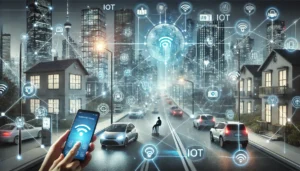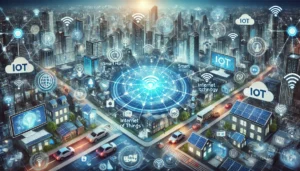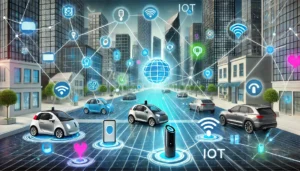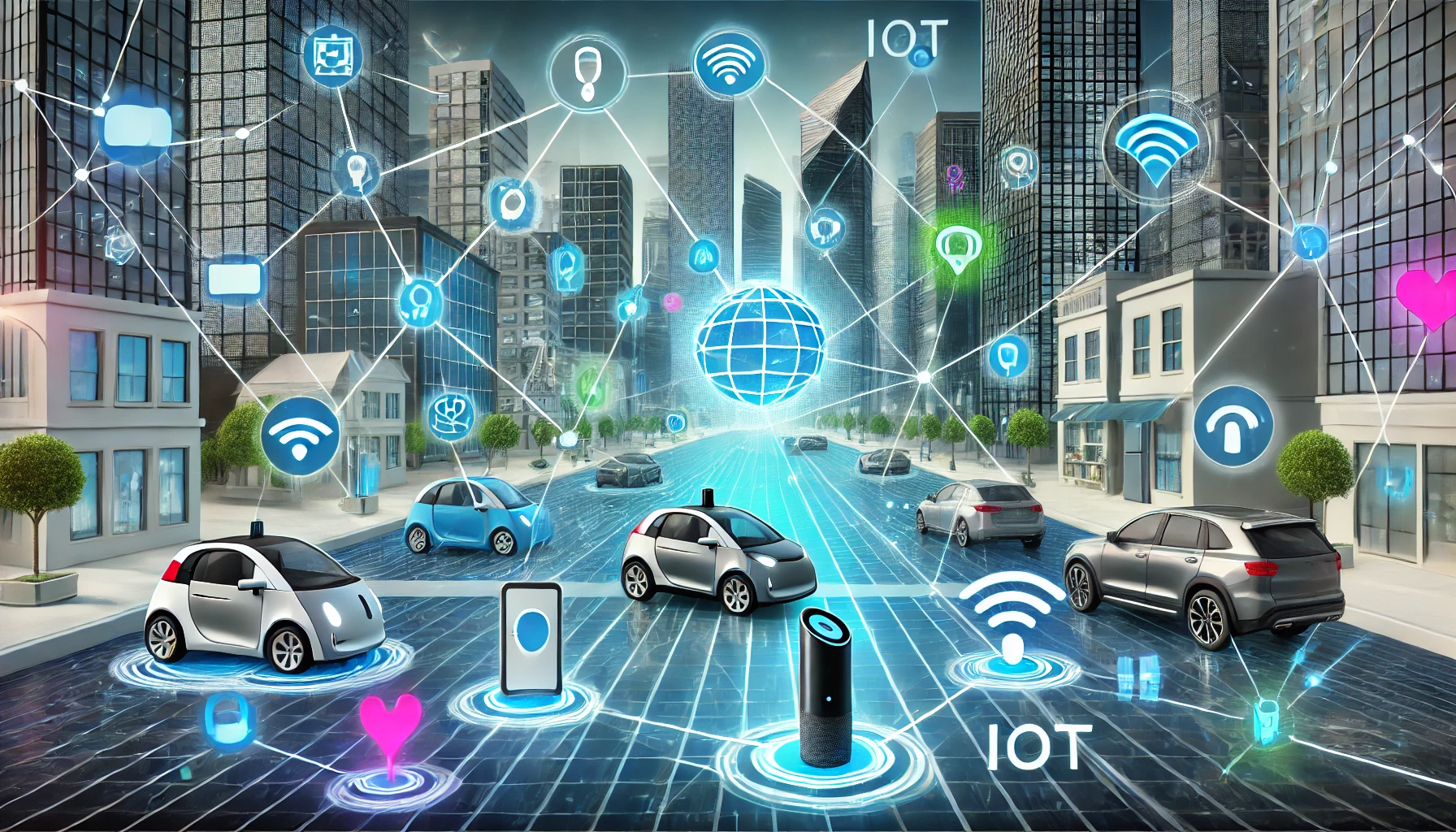
How Smart Technology Transforms Daily Life
The Internet of Things (IoT): How Smart Devices Are Reshaping Our Lives
In an age of rapid technological advancements, the Internet of Things (IoT) has emerged as a game-changer, seamlessly integrating the physical and digital worlds. IoT refers to the interconnected network of smart devices that collect, exchange, and analyze data to enhance efficiency, convenience, and overall quality of life. From smart homes and healthcare to industrial automation and urban development, IoT is transforming the way we live and work.
What is IoT?
The Internet of Things (IoT) is a network of interconnected devices equipped with sensors, software, and connectivity that enable them to communicate with each other and perform automated tasks. These devices range from household appliances like smart thermostats and voice assistants to complex industrial machinery and healthcare monitoring systems. The primary goal of IoT is to create an ecosystem where devices work together to enhance productivity, efficiency, and convenience.
Impact of IoT on Daily Life
- Smart Homes
IoT has revolutionized home automation, making our living spaces more intelligent and efficient. Smart home devices, such as smart speakers (Amazon Alexa, Google Home), thermostats (Nest, Ecobee), security cameras, and lighting systems, allow homeowners to control their environment with voice commands or mobile apps. These technologies improve energy efficiency, enhance security, and provide convenience like never before.
Moreover, IoT-powered appliances such as refrigerators, washing machines, and coffee makers enable automated functionalities, learning user preferences to optimize performance and efficiency. Smart locks and doorbell cameras enhance home security, allowing homeowners to monitor and control access remotely.
- Healthcare and Wearables
In the healthcare industry, IoT has significantly improved patient care and monitoring. Wearable devices like fitness trackers, smartwatches, and medical sensors monitor vital signs such as heart rate, blood pressure, and oxygen levels in real time. Doctors can remotely track patients’ health conditions and intervene when necessary, reducing hospital visits and improving overall well-being.
Beyond wearables, IoT-enabled hospital equipment ensures real-time tracking of medical supplies, bed occupancy, and patient movement, leading to better resource management. Smart pill dispensers remind patients to take medication, reducing the risks associated with missed dosages and improving treatment adherence.
Table of Contents

How Smart Technology Transforms Daily Life
- Smart Cities
IoT is playing a crucial role in urban development by creating smart cities that optimize resources and improve public services. Smart traffic management systems reduce congestion, smart lighting saves energy, and IoT-enabled waste management ensures efficient garbage disposal. These advancements contribute to sustainable and eco-friendly urban living.
Additionally, public safety is enhanced through smart surveillance systems, which use AI-driven analytics to detect potential threats and improve emergency response times. Connected public transportation systems improve efficiency by providing real-time updates on routes and schedules.
- Industrial Automation
Industries are leveraging IoT for automation, predictive maintenance, and supply chain optimization. Smart sensors in manufacturing plants monitor equipment performance and predict potential failures, reducing downtime and increasing efficiency. IoT-powered logistics help track shipments in real time, ensuring smooth supply chain operations.
Furthermore, IoT-driven robotics are streamlining production lines, enhancing efficiency, and reducing human errors. Automated quality control systems detect defects in manufacturing, improving product reliability and reducing waste.
- Agriculture and Smart Farming
Farmers are adopting IoT solutions to improve productivity and resource management. Smart irrigation systems monitor soil moisture levels and weather conditions to optimize water usage. IoT-enabled drones help with crop monitoring, pest control, and yield predictions, leading to higher agricultural efficiency and reduced waste.
Smart livestock management systems track animal health and behavior, ensuring timely medical intervention and improving overall farm productivity. Automated machinery enhances planting and harvesting processes, reducing labor costs and increasing yield.
Challenges and Concerns
Despite its numerous benefits, IoT also poses challenges, including data privacy and security risks. With billions of connected devices exchanging sensitive information, cybersecurity threats such as hacking and data breaches are significant concerns. Additionally, interoperability issues among different IoT devices and networks remain a challenge that needs to be addressed.
Moreover, ethical considerations around data ownership and user privacy must be carefully managed. Governments and organizations are working towards implementing regulations and frameworks to ensure secure and responsible IoT adoption.
The Future of IoT
As technology continues to evolve, IoT is expected to become even more integrated into our daily lives. Advancements in artificial intelligence (AI) and machine learning will enable smarter decision-making and automation. The rollout of 5G networks will further enhance IoT capabilities, providing faster and more reliable connectivity.
In the future, we can anticipate even greater integration of IoT in areas such as autonomous vehicles, personalized healthcare solutions, and advanced energy management. The development of edge computing will reduce reliance on cloud storage, enabling faster and more efficient data processing at the device level.
IoT is reshaping our world, making it more connected, efficient, and intelligent. While challenges exist, the benefits far outweigh the risks, promising a future where smart devices continue to revolutionize industries and improve our quality of life. The journey of IoT has just begun, and its impact will only grow in the coming years, leading to smarter, more sustainable, and data-driven advancements across all aspects of life.

How Smart Technology Transforms Daily Life
FAQs on The Internet of Things (IoT): How Smart Technology is Revolutionizing Daily Life:
- What is the Internet of Things (IoT)?
IoT refers to a network of interconnected devices that communicate and share data over the internet, enabling automation, efficiency, and smart decision-making.
- How does IoT impact daily life?
IoT enhances convenience, security, and efficiency by integrating smart devices such as smart home systems, wearable health trackers, and automated appliances into daily activities.
- What are some common examples of IoT devices?
Smart thermostats (Nest), smart speakers (Amazon Echo, Google Home), fitness trackers (Fitbit), smart security cameras, and connected cars are popular IoT examples.
- How does IoT improve home automation?
IoT allows users to control lighting, temperature, security, and appliances remotely through apps or voice assistants like Alexa and Google Assistant.
- Is IoT secure?
While IoT offers convenience, security risks like hacking and data breaches exist. Using strong passwords, secure networks, and updated firmware can help protect devices.
- How is IoT used in healthcare?
IoT-powered wearable devices track vital signs, monitor chronic conditions, and send real-time health data to doctors, improving patient care and early diagnosis.
- What role does IoT play in industries?
IoT enhances productivity in manufacturing, agriculture, logistics, and retail by enabling automation, predictive maintenance, and real-time data analysis.
- How does IoT contribute to smart cities?
IoT helps develop smart cities by optimizing traffic management, waste disposal, energy efficiency, and public safety through interconnected urban infrastructure.
- What are the challenges of IoT adoption?
Challenges include data privacy concerns, cybersecurity threats, high costs, and interoperability issues among different IoT devices and platforms.
- What is the future of IoT?
The future of IoT includes advancements in AI-powered automation, 5G connectivity, edge computing, and enhanced cybersecurity to further integrate IoT into daily life.
Summary
The Internet of Things (IoT): How Smart Technology is Revolutionizing Daily Life
The Internet of Things (IoT) is a rapidly growing technological revolution that is reshaping how we interact with the world. By connecting everyday devices to the internet, IoT enables seamless communication between smart gadgets, allowing automation, efficiency, and enhanced user experiences in various aspects of life. From smart homes and wearable devices to industrial automation and healthcare advancements, IoT is transforming daily routines, making them more convenient, efficient, and intelligent.
Understanding IoT and Its Mechanism
IoT refers to a network of interconnected devices that collect, process, and exchange data over the internet without human intervention. These devices, embedded with sensors, software, and communication technologies, range from household appliances and security systems to smart cars and industrial machinery. The core components of IoT include:
- Sensors and Actuators – These collect real-time data, such as temperature, motion, or humidity, and initiate responses based on the collected information.
- Connectivity – Devices use Wi-Fi, Bluetooth, 5G, or other networks to transmit data.
- Cloud Computing – The data is stored, analyzed, and processed in cloud platforms, enabling insights and decision-making.
- Artificial Intelligence (AI) and Automation – AI enhances IoT by analyzing data patterns, predicting outcomes, and automating tasks.
IoT in Everyday Life
The integration of IoT into daily activities is making life more convenient, safe, and efficient. Here are some major areas where IoT is revolutionizing everyday experiences:
- Smart Homes – IoT-powered devices such as smart thermostats, voice assistants (e.g., Alexa, Google Home), security cameras, and automated lighting systems allow homeowners to control their environment remotely. Smart appliances like refrigerators and washing machines optimize energy consumption and improve efficiency.
- Healthcare and Wearables – IoT is revolutionizing healthcare with wearable devices like smartwatches, fitness trackers, and remote patient monitoring systems. These gadgets track health metrics such as heart rate, blood pressure, and oxygen levels, enabling early detection of medical conditions and better patient care.
- Smart Cities – IoT plays a crucial role in developing smart cities by improving traffic management, waste management, energy distribution, and public safety. Connected streetlights, real-time traffic monitoring, and pollution control systems contribute to sustainability and efficiency.
- Industrial IoT (IIoT) – Factories and industries are leveraging IoT for predictive maintenance, automation, and efficiency improvements. Sensors monitor machinery performance, reducing downtime and preventing costly repairs.
- Smart Transportation – IoT enhances transportation through GPS tracking, connected vehicles, and smart traffic management. Autonomous cars and smart public transit systems are improving road safety and reducing congestion.
- Retail and Shopping – IoT is changing the shopping experience through automated checkout systems, personalized recommendations, and inventory management. Smart shelves and RFID technology help retailers manage stock efficiently.
Challenges and Concerns in IoT Adoption
Despite its benefits, IoT presents several challenges:
- Security Risks – As devices become interconnected, cybersecurity threats like data breaches and hacking increase. Strong encryption and security protocols are essential to protect user data.
- Privacy Issues – IoT collects vast amounts of personal data, raising concerns about surveillance and data misuse. Regulations and ethical guidelines are necessary to ensure user privacy.
- Integration and Compatibility – Different manufacturers use various IoT protocols, leading to compatibility issues. A unified standard is needed for seamless device interaction.
- High Costs – Implementing IoT infrastructure can be expensive, limiting its accessibility for small businesses and developing regions.
The Future of IoT
IoT is expected to continue evolving, integrating with emerging technologies like 5G, artificial intelligence, and blockchain. Future advancements may include:
- Smarter AI-driven Automation – AI will enhance IoT decision-making, improving efficiency in industries, homes, and healthcare.
- Edge Computing – Instead of relying solely on cloud storage, IoT devices will process data locally for faster and more secure responses.
- Advanced Security Solutions – Biometric authentication, blockchain technology, and improved encryption will strengthen IoT security.
- Expanded IoT Adoption – As technology becomes more affordable, more industries and households will embrace IoT for enhanced convenience and productivity.
Conclusion
The Internet of Things is revolutionizing daily life by connecting devices, automating processes, and improving efficiency in multiple domains. While challenges such as security and privacy must be addressed, the benefits of IoT are undeniable. As technology advances, IoT will continue to shape the future, making life smarter, safer, and more convenient for individuals, businesses, and society as a whole.
Unlock the Ancient Wisdom of Sanatan Dharma – Join Us on YouTube!
👉 Subscribe now to Prachin Sanatan Dharma and embark on a journey of enlightenment.
Explore timeless teachings, spiritual insights, and cultural richness on our YouTube channel, Prachin Sanatan Dharma. Dive deep into the essence of Sanatan Dharma through captivating videos that inspire and educate.
Related Articles
- Restful Nights: Ayurvedic Remedies and Traditional Indian Practices to Overcome Insomnia and Late-Night Habits
- The Tridevi: Lakshmi, Saraswati, and Parvati – Their Roles and Powers
- “Divine Creatures of Ancient Indian Scriptures: Exploring the Role of Animals in the Vedas, Puranas, and Mahabharata”
- Nature and Spirituality: Exploring the Sacred Essence of the Himalayas, Ganga, and Other Natural Wonders”
- “Reviving the Gurukul System: Relevance and Lessons for Modern Education”
- “Exploring Greek and Indian Mythology: Similarities Between Greek and Indian Mythology “
- “Embracing Sattvic Living: Harmonizing Mind, Body, and Soul Through Food and Lifestyle”
- “Charity and Prosperity: Exploring the Concept of Daan and Its Financial Relevance in Modern Life”
- How to Build an Eco-Friendly Home Inspired by Vastu Shastra
- Comparison of Ancient and Modern Sports: How Traditional Sports Have Influenced Contemporary Games
- “Timeless Lessons from Ancient Tales: Linking Samudra Manthan and Ganga’s Descent to Modern Ecological Challenges”
- “Reviving Sanskrit: How AI is Preserving Ancient Languages for the Future”
- “Mathura: The Sacred Land of Lord Krishna’s Divine Leelas”
- Investing for Future Generations: Lessons from Indian Traditions on Legacy Building and Wealth Preservation
- “Ancient Indian Wisdom: Timeless Lessons for Tackling Today’s Climate Crisis”
- “Artificial Intelligence and Spirituality: Transforming Ancient Practices for the Modern World”
- “Gold and Real Estate in India: Timeless Assets Shaping Financial Strategies”
- Tradition Meets Innovation: The Evolution of Technology in Hindu Rituals
- End-of-World Myths: Exploring Kali Yuga in Hinduism and Ragnarök in Norse Mythology
- Garuda, Pegasus, and Dragons: The Universal Ties of Mythical Beasts Across Cultures
- “Ancient Vimanas: Mythical Flying Machines or Evidence of Advanced Technology?”
- Time Travel in Hindu Mythology: The Fascinating Tales of Kakudmi and King Raivata
- “Divine Feminine Power in Hindu Mythology: The Legends of Durga, Saraswati, and Lakshmi”
- “Divine Beings of Sanatan Dharma: The Spiritual Significance of Sacred Animals in Hinduism”
- “Symbolism in Mythological Art: Unlocking Hidden Meanings in Ancient Temple Carvings”
- “Exploring Technological Advancements in Ancient India and Civilizations: Vimana, Metallurgy, & Water Management systems”
- Unveiling the Mysteries: Ancient Temples of Sanatan Dharma , Mysterious Temples of India
- “The Scientific Knowledge of Sanatan Dharma: Ancient Wisdom Meets Modern Science”
- Ancient Indian Sports and Games: Celebrating a Legacy of Skill, Strength & Strategy”
- “Exploring the Cosmic Link: The Connection Between Astronomy and Vedic Astrology”
- The Power of Sanskrit: Unlocking the Divine Language of the Gods
- “The End of Kaliyuga: A Sanatan Insight into the World’s Final Chapter”
- Explore more articles on Prachin Sanatan Yuga.
How Smart Technology Transforms Daily Life How Smart Technology Transforms Daily Life How Smart Technology Transforms Daily Life How Smart Technology Transforms Daily Life How Smart Technology Transforms Daily Life How Smart Technology Transforms Daily Life How Smart Technology Transforms Daily Life How Smart Technology Transforms Daily Life How Smart Technology Transforms Daily Life How Smart Technology Transforms Daily Life
How Smart Technology Transforms Daily Life How Smart Technology Transforms Daily Life How Smart Technology Transforms Daily Life How Smart Technology Transforms Daily Life How Smart Technology Transforms Daily Life How Smart Technology Transforms Daily Life How Smart Technology Transforms Daily Life How Smart Technology Transforms Daily Life How Smart Technology Transforms Daily Life How Smart Technology Transforms Daily Life
How Smart Technology Transforms Daily Life How Smart Technology Transforms Daily Life How Smart Technology Transforms Daily Life How Smart Technology Transforms Daily Life How Smart Technology Transforms Daily Life How Smart Technology Transforms Daily Life How Smart Technology Transforms Daily Life How Smart Technology Transforms Daily Life How Smart Technology Transforms Daily Life How Smart Technology Transforms Daily Life
